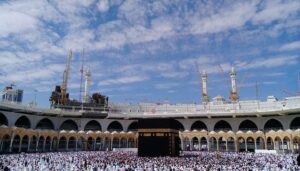
Hajj is also one of the five pillars of Iman. Pilgrimage is also one of the most religious responsibilities for each capable Muslim. Allah Almighty Himself has stated the very same in the Holy Quran:
“It is on people for the sake of Allah to perform Hajj to his house, anyone who can undertake the journey to him” (Quran, 2:196).
It is an obligation on the sound and wealthy Muslims who are compelled to make the pilgrimage in their lifetime. A very religious deed which can be performed by a human being during his/her lifetime.
Sacred Sites of Hajj and Their Historical Importance
Remission of sin is one of the finest and auspicious favours of Allah (SWT) to His servants in Hajj. Religious people can perform this spiritual journey through Hajj packages 2026 from the USA because Hajj provides the chance of remission of sins and a new life in a better world.
In attempting to turn the Hajj pilgrimage into a once-in-a-lifetime experience, it is otherwise ritual-less. Makkah does have some very important religious and historical sites to visit. They tie us with the Prophet ﷺ and early Islamic history, so our pilgrimage is not made meaningless.
Jannat-ul-Maula – The Myths About the Makkah Cemetery
North of Masjid al-Haram is Jannat-ul-Maula. The ancient Makkah graveyard, and among his captives are a few members of the Prophet’s family. These include his wife Khadijah (RA) and his great-great-grandfather Abdul Muttalib.
It’s just such a place, so full of historical and sentimental value, to have a shrine for martyrs to commemorate the early Muslims. Though the visitors are not permitted to go in here today, you can still pray for the body lying in these graves in front of these white buildings.
Mina
Mina is 8km east of Masjid al-Haram, where Pilgrims establish overnight camps for most of the Hajj visit duration. Pilgrims come in 8th Zilhajj and 10th to 13th Zilhajj. Mina is also “the tent city,” which has an unimaginable worth at the Hajj Pilgrimage annually.
Jabal al-Nour – Cave of Hira
Here in Jabal al-Nour (Mountain of Light), that is, where the Prophet ﷺ was given the first revelation by Jibreel (AS) within the Cave of Hira. A historic milestone was achieved.
It makes climbing this mountain a test of one’s faith and bodily endurance. You would relish taking refuge and considering the Prophet ﷺ’s boundless chastity. Finish your hike and rest, and pray for chastity and wisdom in life.
Jabal Thawr – Shelter Cave
It was Jabal Thawr that the Prophet ﷺ and Abu Bakr (RA) had attempted to escape to Madinah from Makkah during Hijrah. To take refuge, they stayed in Cave Thwar. This shows their tawakul in Allah and their trust in His plan. The Prophet ﷺ comforted Abu Bakr (RA) with these words from the quran:
“Do not weep, for verily Allah is with us.” (Qur’an 9:40)
Jabal Thawr is remembered in the Prophet’s self-composure, submission and fortitude.
Jabal Rahmah – Mount of Mercy
His sermons were the final words which included the equity and mercy, Tawheed, brotherhood and justice. Pilgrims in ‘Arafat will usually recite a dua so that they can be guided and show mercy unto them because the day of Hajj is the holiest. Pilgrims who are doing Umrah don’t offer prayers but recite the placasora reminder of Judgement Day.
Masjid Ayesha (Masjid Taneem)
This mosque occupies a 7km radius of Masjid al- Haram. This makes it the 2nd largest mosque in Makkah.
It is a sacred site from where pilgrims arrive to declare Ihram again to conduct the second Umrah. Looking for a place to spend spiritual time? This place is best to pray, reflect, and relax prior to moving further in the direction of Haram.
Maktaba Makkah al-Mukarramah – Most Holy Birthplace of Prophet Muhammad ﷺ
The Banu Hashim in Makkah is the holy place where the Prophet Muhammad ﷺ was born. This place is now the national library, now occupies the old building.
Even though not a house address anymore today, it’s still a place of awe for anyone who would desire to be part of the Prophet’s life ﷺ.
Conclusion
Hajj is old, it’s ancient, and it’s religiously significant to Muslims worldwide. It’s a declaration of a show of reverence to will, convention, and submission to Allah by the Prophet Ibrahim (AS) and his lineage.
And, finally, Allah’s Messenger Muhammad ﷺ made His rituals an example to the Muslim ummah. So we could follow by performing Hajj so that we might be close to Allah.
Pilgrims can also make preparations in advance and organise their schedules by hiring the services of an Islamic travel agency. Indeed, the Hajj history always becomes a cause of concern. It gets millions of Muslims to believe and have faith. Even more so that they become compatible with Allah, and they can perform an act of selflessness.


